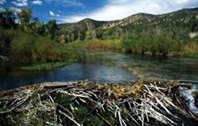Beaver Ponds
Beaver ponds are capable of providing outstanding fishing. They can unexpectedly appear on stretches of small canyon streams that are too small to provide much of a stable fishery. These dams can furnish prime fish habitat where it didn’t previously exist. Their locations are sometimes remote and secretive. I have discovered many of my favorite ponds while out in the woods hunting grouse or deer.
The best ponds are located on sections of a spring creek in remote canyon country. The spring creek’s rich nutrients and stable temperatures allow for abundant aquatic plant growths. Correspondingly, the insects and trout flourish. This stable oxygen content and favorable temperature prevents them from winterkilling and extends the fish’s growing seasons. A beaver dam’s main problem is that their engineers must maintain these dams. Beavers can be here today and gone tomorrow. Their dams are temporary structures. Although their

ponds only need a few seasons to quickly become a quality fishery, the beaver may move on before this happens.
A pond built in a freestone creek can provide good fishing, yet they are vulnerable to high run offs which can wash out dams, draining the pond. This makes freestone creek ponds more likely to vanish whereas spring creek ponds are prone to be there for several seasons. The spring creek’s advantages of ideal temperatures, stable flows, rich aquatic life, and optimal pH make them the best fishing ponds. Whenever exploring a remote canyon in beaver country, keep an eye out for hidden ponds. I once found several while archery hunting a remote drainage in Utah’s Uinta Mountains. A series of about a dozen ponds provided brook trout weighing up to four pounds and cutthroats to three pounds. The fishing was so fantastic that for several years it was the best place I knew to take a beginning flyfisherman. Their first cast would be intercepted by trout swarming the fly from all directions. This fishery lasted for six or seven years yet was eventually abandoned by the beavers and soon deteriorated. I tried to repair one of the failing dams, but I was astounded at the amount of maintenance that they required. Sadly, my efforts were in vain and this great fishery was lost.
Beavers select pond sites adjacent to food supplies such as willow and aspen stands. When hiking in remote canyons where willow or aspen trees grow, search for beaver-chewed trees. Once one is located, you can assume there may be ponds nearby.
When one pond is found, scout out any tributaries nearby in hope of finding more ponds. I usually find them while I’m out hunting when I’m without rod and reel. This happens frequently enough that I now stash in my hunting equipment a tippet spool and a small box of flies. It only takes a minute or two to cut a willow and rig it with a tippet and fly. Seductively dapple a terrestrial fly in the pond to see if it contains fish. If it tests out to be an interesting fishery, return later with your regular tackle.

One advantage of fishing beaver ponds over other lakes is that the fish can be readily caught. Food supplies in beaver ponds are often limited so there is more competition for your fly. Your initial cast may be accosted by several trout with the fastest one being hooked. These trout are usually lightly fished and tend to be naive, foraging type feeders. One downside of good beaver ponds is their remote locations. However, for the serious fly fishermen it’s usually well worth the extra effort to hike to a pond filled with naive fish.
Beaver pond country will sometimes result in a surprise sighting of other wildlife such as elk, deer, bear, grouse, coyote, and squirrels. The wildlife adds to the trip. The easily accessed roadside ponds are often discovered early and quickly over fished. The real finds are the unknown remote ones.
Fishing techniques become simplified. You can see, touch, and feel the entire fishery. Overturning stream rocks and vegetation provides you with a grocery list of the fish’s foods. Walking around the riparian zone informs you about the local terrestrial insects. It only takes a little investigation to quickly deduce which fly may be the most effective. An exact imitation or a general attractor pattern carefully presented will usually bring an immediate response.
Dry fly fishing is my preferred choice because the beaver pond’s surface film is a prime place where most fish feed. After the surface is covered then I probe the channel depths with a sunken fly. I’ve found leeches, small streamers, nymphs, sculpins, and scud patterns seductively retrieved through the old stream channel to be highly effective. Both slow hand twist and quick strip retrieves are good choices. Fish the pond’s deeper waters after you have caught a few on the surface as the frightened fish will seek shelter in these depths.
Tackle requirements are modest. This is a place for an ultra-light outfit. Two and three weight rods, reels and lines are prime choices for these fisheries. Flies are simple assortments of dries, nymphs, streamers, and terrestrials. A floating line and finely tapered leader completes your tackle. Your boxes should easily fit into a jacket pocket and waders are substituted for hiking shoes, although in some wet areas ultra-light waders may be necessary to allow you complete access to the pond’s features.

© 2025 The Gale Group, Inc. All rights reserved.
© 2025 Perigee Learning LLC. All rights reserved.
LoveTheOutdoors.com is owned and operated by Advameg, Inc. © 2025 Advameg, Inc.
Camping Adventures • Dutch Oven Cooking • Sports Knots
Fly Tying • Freshwater Fishing • Fly Fishing

